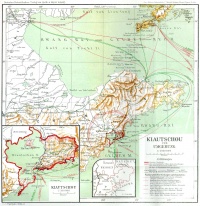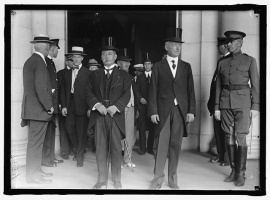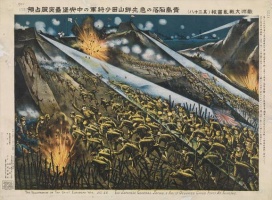Introduction↑
Prior to the First World War, China was in a weak state, especially after the 1911 revolution and 1912 establishment of the Republic of China. This was followed by an extended period of internal turmoil, rebellions, and warlordism. During the First World War, imperial Japan initially managed to gain territory and influence in China. Most importantly, this concerned the only battle in East Asia during the First World War between Japan and Germany, the Siege of Qingdao, held over the capital of the erstwhile German-leased territory in today’s Shandong province. Throughout the war, the territory was occupied by the Japanese, becoming the subject of often secretly held negotiations, including the “Twenty-One Demands” and the Paris Peace Conference. Not until over four years after the cessation of hostilities between the Allied and Central Powers in Europe, in December 1922, did the Japanese return the territory to the Chinese.
German Occupation during the War (1914)↑
In 1897, Jiaozhou Bay (Kiautschou Bucht in German), with Qingdao (Tsingtao) as its capital, was colonized by the Germans. In 1898, a formal lease agreement was reached between the Germans and the imperial Chinese government. The German administrators, diplomats, military, and settlers in the Chinese concession had taken on the challenge of creating a “model colony” (Musterkolonie) with infrastructure and buildings much like those existent in Germany at the time, and some of which, such as the canalization, are still in use in today’s Qingdao.
As Germany acquired possessions in the Pacific, such as the present-day Northern Mariana Islands, Nauru, and Samoa, around the turn of the century, Qingdao became increasingly important for its overall naval strategy. Thus, when the First World War began, the German navy sailed to the ports of the German Pacific islands and, from there, returned to Germany due to the overwhelming presence of the British and Japanese blue navies in the Pacific. Shortly thereafter, on 15 August 1914, Japan gave Germany an ultimatum:
Japan did this knowing that Germany was occupied on two fronts in Europe and, thus, in a weak state to defend their fortification in Qingdao. In addition, Britain, with whom Japan was allied, had declared war against Germany within the European theater of war.
In fact, German diplomats in China, while not seriously considering giving in to the Japanese ultimatum and simply handing over Qingdao, were thinking of a third way, i.e., declaring the German concession a neutral territory during the war. However, this did not materialize in the end, mostly because the warring powers, Britain, France, Russia, and Germany, no longer communicated via the normal diplomatic channels. China, too, considered attempting to take the German concession back by force. However, this was not put into practice. Japan, in alignment with Britain, persuaded the government of Chinese President Yuan Shikai (1859-1916) to stay neutral in the looming conflict. Furthermore, Japan claimed that its intention was to return the concession to China after the war. This occurred at the point when China could no longer gain this territory by itself.
The Siege of Qingdao (August-November 1914)↑
Naturally, the Germans could not simply accept the capitulation of their “Musterkolonie”. Wilhelm II, German Emperor (1859-1941) allegedly told the German Governor and highest military commander, Vice Admiral Alfred Meyer-Waldeck (1864-1928), that “to lose Tsingtao to the Japanese would shame Germany more than to lose Berlin to the Russians.”[2] The ultimatum expired at 12 pm on 23 August 1914, after which Japan declared war on Germany. On 25 August 1914, Japan’s government also declared war against the Austro-Hungarian Empire due to the continued presence of an Austro-Hungarian warship, the Kaiserin Elizabeth, in the waters around the German concession. The Japanese then imposed a blockade starting August 27, 1914. In so doing, it sought backing from Britain, although Japan’s European ally would only play a supporting role, as “[t]he Japanese minister for foreign affairs [had] interpreted [communication by the British] to mean that Great Britain conceded to Japan a free hand to act (…) independently.”[3] Though, interestingly, Britain tried to place restrictions on Japan, recommending that France and Russia should also be invited to join in the attack on Qingdao in order to give it a pan-Allied character.[4] Japan ignored these suggestions and continued its advance, making it a mostly Japanese endeavor while including Britain only to comply with the alliance that the two had forged in 1902. After all, this was to be only the second Japanese attempt at defeating a European great power after the 1904-05 Russo-Japanese War, although nobody doubted that the Japanese would emerge victorious given that German forces numbered only about 6,000, a figure that included some 3,000 reserves, most of whom were merchants in China.[5] Indicative of the limited British role was the deployment of a British-Indian regiment which was put under the authority of the Japanese military. It consisted of 500 Sikhs and one battalion of British infantry under the command of Colonel Nathaniel Barnardiston (1858-1916), who wanted his unit to be given independent status but was told that it would be subordinate to Britain’s Asian ally.[6]
In addition to coordinating their moves with the British, the Japanese were also in close contact with the Chinese government of Yuan Shikai. They expressed their sincerity in wanting only to defend the peace in East Asia without any intentions of conquering territory in China. However, in initiating the siege and eventual attack on Qingdao, the Japanese first sent troops inland starting out at Longkou, north of Qingdao,[7] and travelling along the railroad from Qingdao to Jinan, the provincial capital of Shandong. In the eyes of historian Jonathan Fenby, “Japan’s choice of landing site for the force sent to take Tsingtao showed the hollowness of its claim that it sought no territorial aggrandizement and wanted only to protect the integrity of China.”[8] Because of the advance of Japanese troops not just around the Jiaozhou Bay but into the inland of Shandong peninsula, the Chinese government converted Longzhou, Laizhou and the vicinity of Jiaozhou, the Chinese city after which the German leasehold was named, into a war zone within which China could not hold herself responsible for the maintenance of strict neutrality.[9] At this time, the Chinese spoke of “neutrality,” since their official policy during the First World War was one of neutrality. However, discussion continued about Chinese war aims (among which there were also voices sympathetic to the Germans) until this policy was finally abandoned in 1917 for an entry on the side of the Allies. As Japan took control of the Qingdao-Jinan railroad, China took offense, arguing that the railway was a Chinese-German enterprise and thus, not simply German public property that could be seized by Germany’s enemies.[10] However, China’s protestations were to no avail. Effectively, this meant a violation of Chinese neutrality and sovereignty by Japan despite its promises to the Chinese government to focus its efforts only on Qingdao and the German colony itself.
On 18 September 1914, a second Japanese landing took place in the south of Shandong peninsula, eighteen miles from Qingdao.[11] Under the command of General Kamio Mitsuomi (1856-1927), allied troops steadily made advances approaching Qingdao. However, despite their advantage in numbers, weather, uncertainty about the numbers of German forces, and the cautious style of the Japanese general resulted in a prolonged effort to capture the entire German concession.[12]
On 17 October, Japan also initiated naval operations, and two weeks later began to besiege Qingdao itself. The battle of Qingdao is important in military history not only because it constituted the only battle in Asia during World War One, but also since it was the first hybrid battle of war planes bombing a city in concert with naval operations, making it the first air sea battle in history.
Meyer-Waldeck eventually gave in to the mounting pressure and the advance of the allied forces on 7 November 1914, requesting surrender negotiations. By 22 November 1914, Qingdao was under the full control of the Allies. In the aftermath, most of the German prisoners of war were transferred to Japan for the remainder of the war. Also notable was the fact that Japan did not share the fruits of conquest with its British partner although the latter had taken part in the operations. There was, however, little objection from Britain as they had already virtually ceded Kiaochow to Japan.[13]
Twenty-One Demands (January 1915)↑
On 18 January 1915, the Japanese Minister in Peking, Hioki Eki (1861-1926), personally presented what came to be known as the Twenty-One Demands to Yuan Shikai.[14] These demands made by the Japanese towards the Chinese were divided into several groups, stipulating economic, territorial, diplomatic and political influence. Had these demands been accepted in full by the Chinese government, they would have resulted in supreme status for Japan over China. China thus would have been reduced to a vassal state, if not a colony. The demands included advantageous trade terms, exclusive economic rights in certain areas and industries, and so on. Minister Hioki had expected Yuan to maintain strict secrecy, but word of the demands soon got out.[15] Even so, initially, the international community did not react as forcefully as the Chinese would have wished. The Allies, including Russia, were preoccupied with fighting Germany. Obviously, none of the belligerent powers was going come to China’s aid.[16] Only the U.S., which did not actively partake in the war at that time, issued at least a formal diplomatic objection, stating it would not recognize any agreements that might contravene the Open Door Policy which the U.S. had initiated in 1899 and acted as its main guarantor throughout the early 20th century, or China’s territorial integrity. The Japanese ignored this declaration.[17]
Months went by, presumably as a tactic employed by the Chinese government to buy time and wait for an intervention by the great powers in case the war was to be finalized quickly in Europe. Eventually, the Japanese grew tired of waiting. On 7 May 1915, Minister Hioki presented an ultimatum requiring Chinese acceptance of all demands except those in the fifth group, which, Hioki said, the Japanese government would undertake to detach from the current negotiations and discuss separately in future. Yuan accepted the ultimatum the following day, and China signed the agreement on 25 May.[18]
In popular Chinese memory, Yuan has been branded a traitor for accepting the Twenty-One Demands. In reality, Yuan and his lieutenants worked hard to minimize harm to China’s sovereignty.[19] The Chinese government not only tried to stall the process and leaked the demands in the false hope that the international community would intervene, but they also held protracted negotiations and sought to affect Japanese domestic politics by mobilizing the support of the “elder statesmen” (genrō). These were a group of appointed advisers to the Japanese Emperor who had dominated the political scene since 1868. By the early 20th century, they had given way to political parties and cabinets, but the surviving genrō still held important political influence.[20] Later, under a different leadership in 1918, China would reconfirm that Japan could keep its interests and territory in Shandong in return for financial support from their East Asian neighbor.
Japanese Occupation during and after the War (1914-22)↑
After having successfully taken and effectively conquered the erstwhile German concession, the Japanese reopened Tsingtao to commerce on 21 December 1914, at which time there were still 16,000 Japanese soldiers in the leased territory.[21] Though the Japanese had made empty promises to the Chinese (and Americans) that the leasehold was to eventually be handed back to China, the behavior of the troops and administrators of Jiaozhou Bay gave off a very different impression, namely that the Japanese were there to stay.
Evidence for their underlying motives is that the Japanese built military railways in northeastern Shandong, appropriated Chinese telegraph facilities and post offices, and used the latter for the trafficking of opium. They levied taxes on the Chinese inhabitants, requisitioned labor and material, and attempted to appoint forty Japanese customs officers.[22] These officers were stationed at the Chinese Maritime Customs, which had a special status in Qingdao and was headed by a German. The customs service’s officers were usually Westerners. Japan tried to continue this practice established by the Germans. The spirit of what the Germans had aimed to do in Jiaozhou, namely to build a settler colony based on methods and materials used in Germany itself, thus continued under Japanese rule.
Conclusion: The Return of Qingdao to China after the War (1922)↑
As keen as Woodrow Wilson (1856-1924) was on realizing his “Fourteen Points” ideals—first and foremost the League of Nations, giving in to Japan’s demand to keep Shandong for the moment was a moderately small price for him to pay. Wilson needed Japan’s support for the League of Nations. Furthermore, under the 1917 Lansing-Ishii Agreement, the Japanese retained control of Shandong. Although the act of transferring territorial and economic rights over the Jiaozhou Bay concession (including the Shandong Railway) from Germany to Japan, as stipulated in the Peace Treaty of Versailles, was against Wilson’s ideals of self-determination, it was nevertheless necessary in order not to alienate the Japanese, who were necessary for Wilson’s League of Nations project. Although these rights and concessions were intended to eventually be returned to China, this agreement amounted to a compromise. The Chinese delegation protested heavily, refusing to sign the Versailles Peace Treaty.
The news of the unfavorable peace treaty aroused a massive nationalist reaction from the Chinese public which came to be known as the May Fourth Movement. Despite the pressure that these protests conveyed, Japan also attempted to ignore these for a long time and would continue to rule over the Jiaozhou Bay and vast parts of the Shandong Peninsula for several years after the Versailles Peace Treaty had been signed. Eventually, though, Japan had to give in to the pressure built up by the Chinese and the international community.
The solution to what was then known as the “Shantung Problem,” “Shantung Question” or “Shantung Issue,” was eventually agreed upon at the Washington Naval Conference under the leadership of the U.S. which mediated between Japan and China. This resulted in the “Treaty between China and Japan for the settlement of outstanding questions relative to Shantung,” being signed on 4 February 1922 and ratified by both nations on 2 June 1922. Finally, in December of 1922, the governance of the territory was restored to the Chinese. “Though the Shantung concessions were formally returned to China in 1922, Japan maintained a military presence there, ostensibly simply to defend its residents in the province, plus effective control of the railway.”[23] Thus, de facto, Shandong remained in the sphere of influence of Japan, arguably, until the end of the Japanese occupation of China during the Second World War in 1945.
Lukas K. Danner, Florida International University
Section Editor: Guoqi Xu
Notes
- ↑ Chi, Madeleine: China Diplomacy, 1914-1918, Cambridge, MA 1970, p. 13.
- ↑ Murphy, Mahon: Colonial Captivity during the First World War: Internment and the Fall of the German Empire, 1914-1919, Cambridge 2007, p. 170; partially quoted from Nish, Ian: Alliance in Decline: A Study of Anglo-Japanese Relations, 1908-1923, London 1974, p. 134.
- ↑ Chi, China Diplomacy 1970, p. 12.
- ↑ Fenby, Jonathan: The Siege of Tsingtao: the only battle of the First World War to be fought in East Asia, Victoria & Beijing 2014, p. 32.
- ↑ Chi, China Diplomacy 1970, p. 22.
- ↑ Fenby, The Siege of Tsingtao 2014, p. 34.
- ↑ Chi, China Diplomacy 1970, p. 22.
- ↑ Fenby, The Siege of Tsingtao 2014, p. 37.
- ↑ Chi, China Diplomacy 1970, p. 21.
- ↑ Ibidem, p. 22.
- ↑ Fenby, The Siege of Tsingtao 2014, p. 41.
- ↑ See Fenby, The Siege of Tsingtao 2014, p. 44.
- ↑ Chi, China Diplomacy 1970, p. 15.
- ↑ Clubb, O. Edmund: 20th Century China, Third Edition, New York 1978, p. 52.
- ↑ Ibidem, p. 52.
- ↑ Ibidem, p. 52.
- ↑ Ibidem, p. 52.
- ↑ Ibidem, pp. 52-53.
- ↑ Huang, Yanzhong: China, Japan, and the Twenty-One Demands, 2015, online: https://www.cfr.org/blog/china-japan-and-twenty-one-demands (retrieved 21 August 2018).
- ↑ Ibidem.
- ↑ Chi, China Diplomacy 1970, p. 27.
- ↑ Ibidem, p. 26.
- ↑ Fenby, The Siege of Tsingtao 2014, p. 65.
Selected Bibliography
- Elleman, Bruce A.: Wilson and China. A revised history of the Shandong question, Armonk 2002: M. E. Sharpe.
- Fenby, Jonathan: The Siege of Tsingtao. The only battle of the First World War to be fought in East Asia, Melbourne 2014: Penguin Books.
- Gerwarth, Robert / Manela, Erez (eds.): Empires at war, 1911-1923, Oxford 2014: Oxford University Press.
- Saitō, Seiji: Nichidoku Chintao sensō (The Japanese-German war over Qingdao), Tokyo 2001: Yumani shobō.
- Sa, Na / Sun, Chengshu / Yu, Dinghui (eds.): Diyici shijie dazhan shi (A history of the First World War), Zhangjiakou 1979: Renmin Chubanshe.
- Schmidt, Jan / Schmidtpott, Katja (eds.): The East Asian Dimension of the First World War. Global entanglements and Japan, China and Korea, 1914-1919, Frankfurt a. M. 2017: Campus Verlag.
- Wood, Frances / Arnander, Christopher: Betrayed ally. China in the Great War, Barnsley 2016: Pen and Sword Military.
- Xu, Guoqi: Asia and the Great War. A shared history, Oxford 2017: Oxford University Press.
- Xu, Guoqi: China and the Great War. China's pursuit of a new national identity and internationalization, Cambridge 2005: Cambridge University Press.














